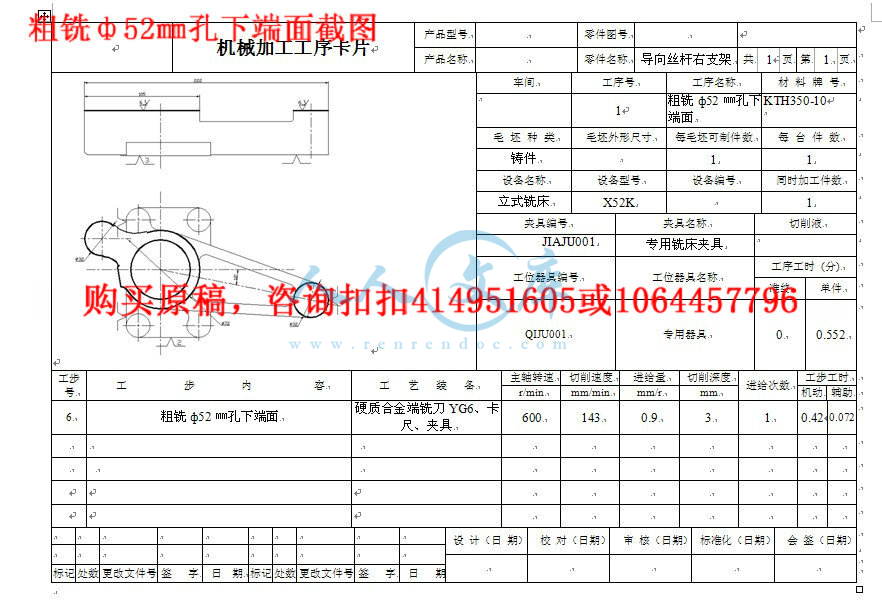摘 要
本次设计内容涉及了机械制造工艺及机床夹具设计、金属切削机床、公差配合与测量等多方面的知识。
导向丝杆右支架的加工工艺及铣端面夹具设计是包括零件加工的工艺设计、工序设计以及专用夹具的设计三部分。在工艺设计中要首先对零件进行分析,了解零件的工艺再设计出毛坯的结构,并选择好零件的加工基准,设计出零件的工艺路线;接着对零件各个工步的工序进行尺寸计算,关键是决定出各个工序的工艺装备及切削用量;然后进行专用夹具的设计,选择设计出夹具的各个组成部件,如定位元件、夹紧元件、引导元件、夹具体与机床的连接部件以及其它部件;计算出夹具定位时产生的定位误差,分析夹具结构的合理性与不足之处,并在以后设计中注意改进。
关键词:工艺、工序、切削用量、夹紧、定位、误差。
Abstract
This design content has involved the machine manufacture craft and the engine bed jig design, the metal-cutting machine tool, the common difference coordination and the survey and so on the various knowledge.
The reduction gear box body components technological process and its the processing jig design is includes the components processing the technological design, the working procedure design as well as the unit clamp design three parts. Must first carry on the analysis in the technological design to the components, understood the components the craft redesigns the semi finished materials the structure, and chooses the good components the processing datum, designs the components the craft route; After that is carrying on the size computation to a components each labor step of working procedure, the key is decides each working procedure the craft equipment and the cutting specifications; Then carries on the unit clamp the design, the choice designs the jig each composition part, like locates the part, clamps the part, guides the part, to clamp concrete and the engine bed connection part as well as other parts; Position error which calculates the jig locates when produces, analyzes the jig structure the rationality and the deficiency, and will design in later pays attention to the improvement.
Keywords: The craft, the working procedure, the cutting specifications, clamp, the localization, the error.
目 录
1序言1
1.1零件的分析1
1.1.1零件的作用1
1.1.2零件的工艺分析..........................................................1
1.2确定毛坯........................................................................2
1.2.1确定毛坯种类..............................................................2
1.2.2确定铸件加工余量及形状............................................2
2工艺规程设计...................................................................3
2.1定位基准的选择.............................................................3
2.2制定工艺路线.................................................................4
2.3机械加工余量、工序尺寸及公差的确定.........................4
2.3.1圆柱表面工序尺寸.......................................................4
2.3.2平面工序尺寸..............................................................6
2.3.3确定切削用量及时间定额............................................6
3夹具设计.........................................................................21
3.1问题的提出..................................................................21
3.2夹具设计......................................................................21
3.3夹具结构设计及操作简要说明......................................22
4参考文献.........................................................................23
1序言
机械制造工艺学课程设计是我们学完了大学的全部基础课、技术基础课以及大部分专业课之后进行的.这是我们在进行毕业设计之前对所学各课程的一次深入的综合性的总复习,也是一次理论联系实际的训练。因此,它在我们四年的大学生活中占有重要的地位。
就我个人而言,我希望能通过这次课程设计,了解并认识一般机器零件的生产工艺过程,巩固和加深已学过的技术基础课和专业课的知识,理论联系实际,对自己未来将从事的工作进行一次适应性训练,从中锻炼自己分析问题、解决问题的能力,为今后的工作打下一个良好的基础,并且为后续课程的学习大好基础。
由于能力所限,设计尚有许多不足之处,恳请各位老师给予指导。
1.1零件的分析
1.1.1零件的作用
题目给的零件是导向丝杆右支架,它位于车床丝杆的右端,主要作用是支撑导向丝杆。法兰盘上有四个安装孔,其中部的通孔则由丝杆穿过,本身没有受到多少力的作用。该零件年产量为4000件,设其备品率为4%,机械加工废品率为0.5%,则该零件的年生产纲领为:N=Q m(1+a%)(1+b%)=4000×1(1+4%)(1+0.5%)=4181(件/年),零件的年产量为4181件,查表可知该产品为中批生产。








 川公网安备: 51019002004831号
川公网安备: 51019002004831号